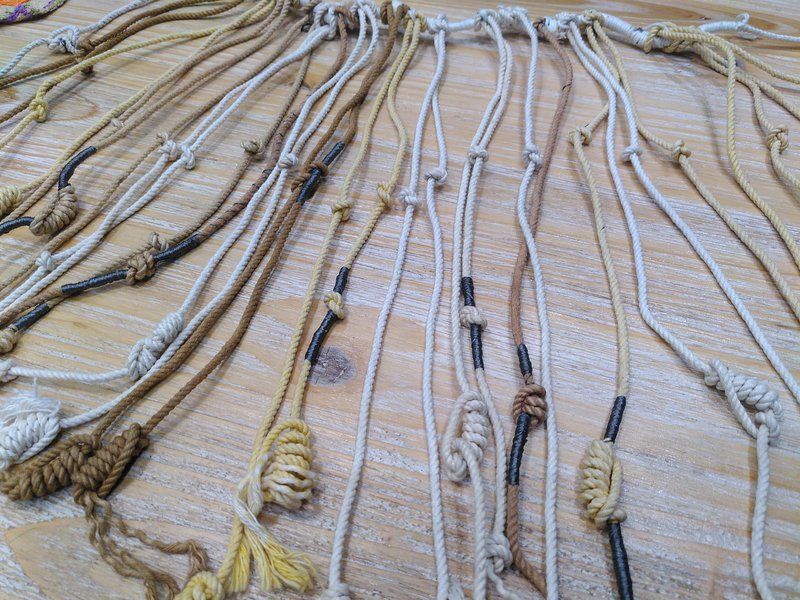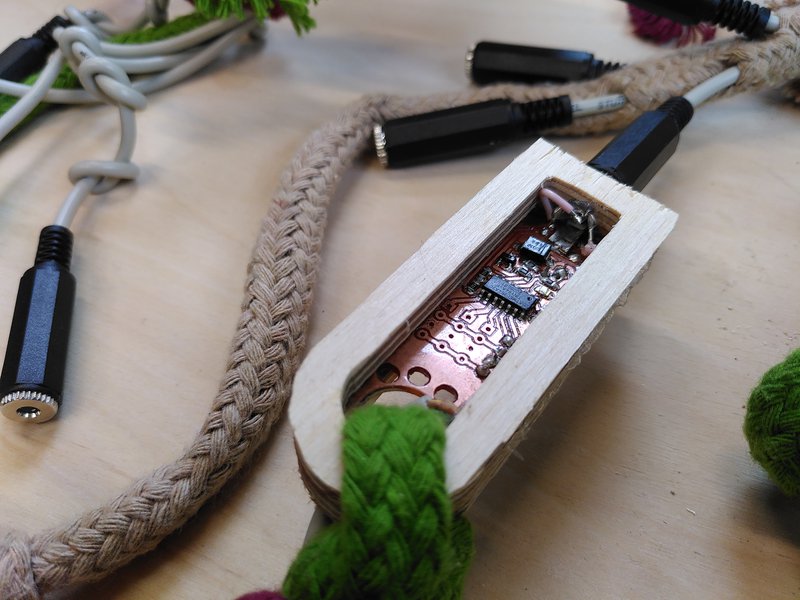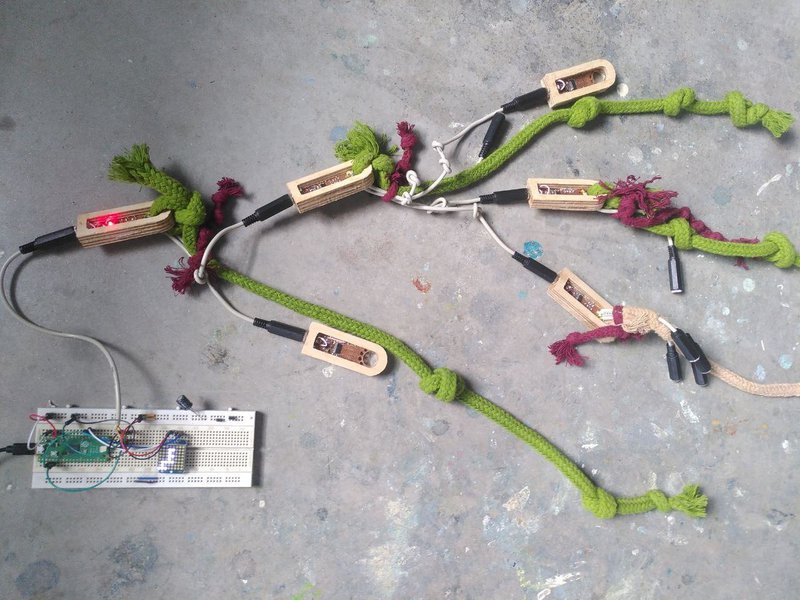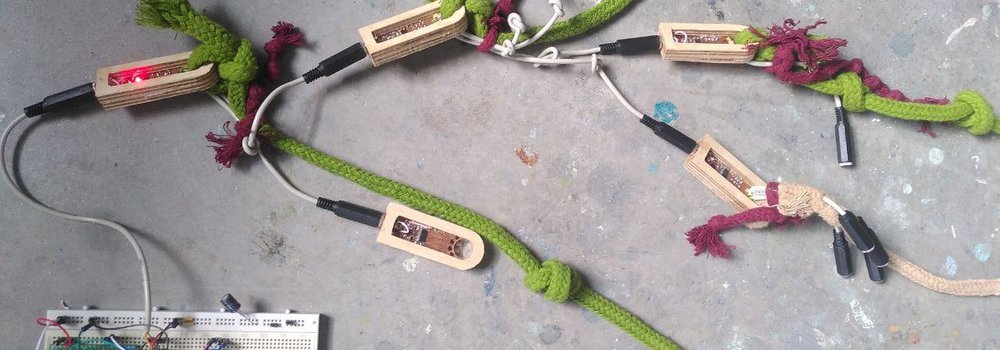When working on the Penelope project, we were able to situate our work within Greek antiquity in a playful and irreverent manner - we could approach classical history with ease, and mix in all sorts of ridiculous influences (livecoding, robotics and maypoles) to make it meaningful for people today. This is possible because rightly or wrongly, ancient Greece holds a privileged position for European culture and power. It can put up with a bit of irreverent lighthearted appropriation because the people of that civilisation are long gone, and it is held dear to the powerful in our society.
A world superpower when it comes to textiles is of course the culture of the Andes. To help us situate ourselves in this very different world, we have been working with Paola Torres Núñez del Prado who has been helping connect the dots between the history and current situation in the region.

Image above: Touch sensitive Khipu that Paola Torres Núñez del Prado constructed for performing electronic music.
One of the incredible people Paola has told us about is Lourdes Huanca Atencio, President of the Federation of Peasant, Artisan, Indigenous, Native and Salaried Women of Peru (FENMUCARINAP). This is a quote from a “Our Demands Are Now Political:” an interview with her about what is happening in Peru: By Elisa Fuenzalida
They want us as a tourist attraction, as decorative objects, as “the cholita with her llama” for their photos, not as people conscious of the knowledge they safeguard and as political agents. We know that while they poison the Earth, we cool the planet and guarantee food sovereignty. We know that cities do not feed on gold, silver, and copper, that they depend on us for food. We know that our worldview is invaluable for the survival of life on this planet. And today we have risen up against racism, against the contempt for Indigenous blood.
There is a tendency in the arts which echoes this 'tourism' attitude we need to be aware of - to put on an explorers hat and wander off to 'discover' amazing artefacts or practices, and feel that we can do our bit by displaying them completely out of context to others in the 'universal culture', who will be enlightened and praise us for our collecting abilities. What we can do with ancient Greece we cannot to with the Inca. Today Andean culture in general and the people of Peru in particular are facing a situation of extreme political suppression. For us to extract 'inspiration' from Andean culture in this way and not speak of these issues would follow a corrosive local trend (speaking as someone born in Britain) - to occupy, idealise, simplify and extract that famously goes back a very long time.
One of the important methods of idealisation is to ignore or sideline any contemporary complexities - and Khipu are a perfect example of this. The view of many academics in anthropology departments is that Khipu belong entirely to the Inca, and all use ended in 1572 when Túpac Amaru - the last ruler, was executed. Khipu in fact existed long before the Inca (examples from the Wari culture from 600–1000 CE) and are still used as part of modern Andean culture, a symbol of an identity and a social system which is under threat.
Video: Beyond History: The Quipus Of Tupicocha by Paola Torres Núñez del Prado
One of the Algorithmic Pattern project's main aims is to study heritage algorithms, which gives us an important opportunity to embed these political realities into our work, and make the results all the more rich for that. The Andean people are one of the few who are literally "cooling the planet", and their social systems contain many aspects that we have no choice but to learn from if we want to have a future. We need to place ourselves in the role of students, as beginners rather than representatives of an overarching universal culture that knows the best way to do everything, when it is increasingly obvious to everyone that we don't.
In the same spirit as our investigations attempting to simulate different forms of weaving, we are building experimental Khipu technology - not as a way to claim we can offer direct benefit to weavers or Andean peoples by doing so, but as a way to understand them better. They are important as a way that people have been manipulating digital information for millennia, are they able to address problems in our current, and largely unchallenged methods of doing the same thing?
This is of course, a form of cultural appropriation, but one where we do not seek to own, profit or extract - but as a way to build objects that allow us to talk well about Andean culture. By merging knot based digital technologies with electrical ones we can demonstrate their equivalence, bring them into the same framework and demonstrate the advantages of each, following our usual open source methods. We have had some success bringing these kinds projects into different cultures and situations (for example when Ellen took the pattern matrix to Chirala, where it was tried out by Indian hand weavers) so one day we hope we can make something that works well enough to be appropriated in turn.
To start with, we've been building a kind of successor to the Pattern Matrix. This will extend our exploration of tangible interfaces into manipulation of hierarchical structures (such as those used to describe software). The underlying concept is that a focus on accessibility through tangibility makes things that are better for everyone.

Image: Close up on a single pendant circuit board, plugged into it's parent. Knotted coloured rope is used to denote the identity of the parent.
For the moment we have a handful of 'pendants' which are knotted cords tied to a 3.5mm plug and with a series of sockets. Each pendant can connect to a number of "child" pendants below it, and plugged into its own parent pendant. The plugs are a weak imitation of the knot tying processes used to construct a khipu, but are also a nod towards electronic music/analogue computers and their patch cords. Each pendant also has it's own haptic feedback in the form of a tiny vibration motor. The top of the tree is a microcontroller board that can read the resulting structure, and currently represents it as a diagram on an LED display.

Image: A hierarchical structure connected together, which is read and displayed in graphical form on the tiny screen on the breadboard.
The concept is to emulate the complex structures more commonly found in pre-Inca Wari khipu, and hopefully emulate potential advantages over, for example written text descriptions of a language - by allowing for structures to be unplugged and re-inserted elsewhere without need to be re-written. We have a long way to go, but the main use case we are aiming to test these devices for is in education, perhaps more specifically programming music with visually impaired children.

